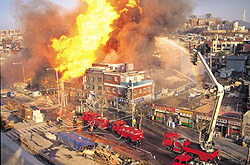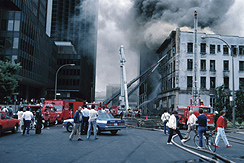Welcome to ATSDR’s Rapid Response Registry (RRR) Web site. The RRR helps local and state public health and disaster response agencies rapidly establish registries of persons who are exposed or potentially exposed to chemicals or other harmful agents during catastrophic events.
ATSDR’s RRR survey instrument gives local and state entities a tool to register responders and other persons exposed to chemical, biological, or nuclear agents from a disaster. The survey instrument is a two-page form that can be distributed on paper or electronically. It can be implemented quickly to collect information rapidly to identify and locate victims and people displaced or affected by a disaster. It requires five minutes or less to collect basic information, such as:

- Demographics (e.g., name, age, sex, home address, status and place of employment)
- Health information
- Exposure information
- Exposure-related health effects
- Immediate health and safety needs
- Health insurance
For mass casualty events, ATSDR identified four critical fields that would be sufficient to establish an official registry record and require only about 90 seconds to complete for each registrant. These are the registrant’s
Get the RRR Survey Instrument
- Survey Form [DOC - 108 KB]
- Download the RRR Training CD [ZIP - 74 MB]
- ACE ToolKit - Database Available
Use the Supporting Documents
What is a Registry?
 A registry is a database of information collected on a select group of individuals. Data collected for registries are generally maintained over time and can be useful for learning about environmental exposures, disease characteristics, and risk factors. The data collected for registries can be helpful to registrants, health professionals, and the scientific community.
A registry is a database of information collected on a select group of individuals. Data collected for registries are generally maintained over time and can be useful for learning about environmental exposures, disease characteristics, and risk factors. The data collected for registries can be helpful to registrants, health professionals, and the scientific community.
How is the Rapid Response Registry Used?
The information collected by ATSDR’s Rapid Response Registry (RRR) survey instrument can be used to:
- Support real-time needs assessment during an emergency affecting public health
- Assess future needs for medical assistance, health interventions, and health education for public health planning purposes
- Contact enrolled individuals with information regarding potential exposures and adverse health impacts, health updates, available educational materials, and follow-up services
ATSDR widely disseminated the RRR survey instrument. It is currently used by at least 22 state health departments in their state-wide disaster preparedness plans. The RRR survey instrument was also acknowledged in the following reports:
- Report To Congressional Requestors [PDF - 530 KB] (U.S. Government Accountability Office, 2008)
How was the Rapid Response Registry Made?
The ATSDR Rapid Response Registry (RRR) was developed using experience gained after the following events:
- Oklahoma City bombing
- World Trade Center response
- Three-mile Island nuclear accident
- Chernobyl nuclear accident
The survey instrument was developed and revised based on extensive input from federal agencies, state and local health officials, and emergency responders. It was tested and further revised during 10 field exercises and national TOPOFF exercises and National Level Exercises (NLE) http://www.dhs.gov/files/training/gc_1179350946764.shtm.
Related Links
The ATSDR Rapid Response Registry (RRR) was developed using experience gained after the following events:
- Page last reviewed: June 26, 2015
- Page last updated: April 8, 2014
- Content source:



 ShareCompartir
ShareCompartir